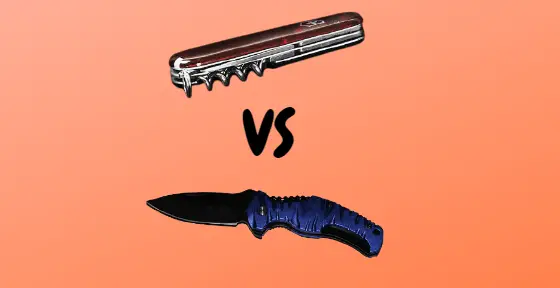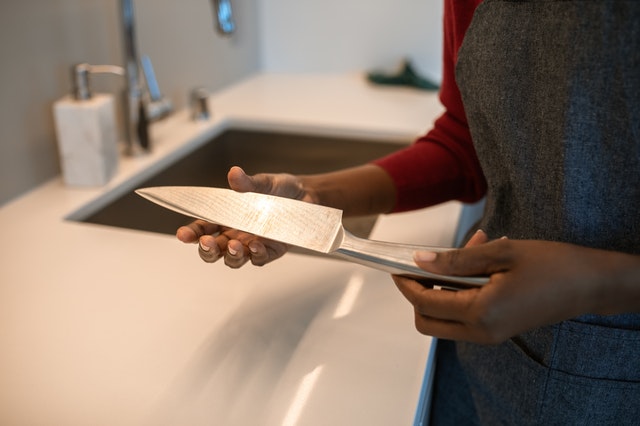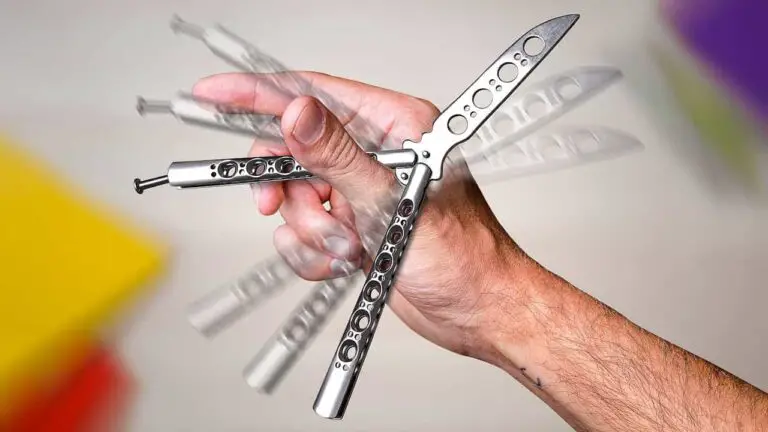Knife fighting looks cool in the movies, but don’t go seeking it out.
If there is one thing the movies get right – from the latest installation of the Mortal Kombat series to the popular Extraction – it is that a using a knife for self defense ends with two people wounded.
The only thing that you can hope for is to leave with lesser and non-mortal wounds than your attacker manages.
This is why I would always recommend that you never carry a weapon for self-defense if you don’t know what you’re doing. Likewise, don’t start taking out your knife at the slightest confrontation.
That said, here’s everything you should know about how to use a knife for self-defense.
Table of Contents
Before Getting into a Knife Fight

Before it ever happens that you have to draw your knife in a fight, make sure to have all of these locked down.
The Laws
You need to know the open carry laws in your region/ province before you even think about carrying a knife for self-defense.
On the one part, check to see if open or concealed knife carry is even legal in the region where you live. Once you have that down, and it’s a positive, check to see what kind of knives are legal.
When I discussed these open carry laws, you would see how they vary by state and the kinds of knives allowed. Make sure to stay within those confines.
Your Choice of Knife
What is the best knife for self-defense?
Well, fixed blade knives will do the magic most times but they are harder to carry everywhere. However, the same fixed blade knives are not the best choice for concealed carry.
At the same time, you don’t want to carry knives that are specially designated for violent situations. The last thing you need is for a lawyer claiming how you were found with such a knife, so you must have been looking for someone to use it on.
That said, different knives have been recommended by experts over the years.
I found some of them, the experts that recommended them, and you could get them all on Amazon:
- Spyderco Matriarch 2 – Lightweight, sturdy, functional.
- Fox Black Emerson Wave Folding Karambit – Sharp, effective, purpose-designed
- Cold Steel Leatherneck Tanto – budget pick, sturdy, swift
- Smith & Wesson Assisted Folding Knife – Small, practical, effective
- Kershaw Secret Agent Knife – need I say more?
Human Anatomy Knowledge
You don’t need to spend plenty of hours learning different knife fighting techniques and strategies if you focus on the human anatomy first.
See, you can stab someone in the back seven times or more and they will still stand up, ready to have a go at you.
Take a jab at their liver or sever a major artery and you’ll have your opponent trying to save themselves rather than keep worrying about you. That gives you all the time to run, call for help for them and report to local law enforcement.
Study the pain points in the human body. Focus on the parts where you can easily reach (and are equally mortal) without many maneuvers.
For example, it is easier to reach a part on the main body than if you were targeting the neck.
Gauge the Situation
I have said this before but, please, allow me to say this again.
If you are defending against an assailant, think about de-escalating the situation before wondering how you can flip out your knife instead.
Many knife fights end with the attacker gaining the upper hand, or cutting their opponent too.
Unless it is a life-or-death situation, don’t even think about that knife for self-defense in the corner of your jacket.
Is the attacker asking for your wallet? Watch? Some spare cash? Give it to them and run away.
That doesn’t make you a coward. If anything, your attacker is the coward for coming onto you like that.
Be Mentally Prepared
When the situation happens that you have to use your knife, keep in mind that you will get a cut/ slash your way too.
At this point, you are fighting for survival since you have gauged the situation and this is the only way out. Thus, suffering some non-fatal harm to your body is better than losing your life altogether.
Don’t always be ready to use
This sounds strange but I can swear to you that it works.
There is a high chance that your attacker was just looking to score a cheap win. They did not expect any resistance so seeing you draw a knife could make them back down.
The danger here comes when you draw your knife and advance on the opponent at the same time.
Maintain a distance, draw your knife and point it at your attacker. Gauge their body language and motion from that point.
If they make to leave, don’t pursue. Find the nearest exit and run – and report to a law enforcement officer if one is around. Should the attacker make the move to advance on you, though, be prepared to unleash deadly force.
How to Control the Knife Fight Better

Now, you are in the knife fight and your opponent is not backing down either.
You have carefully considered all the points from above. Your adrenaline is rushing and you just want to get things over with as fast as possible.
Here are some pointers to help you.
Have the Right Grip
Your grip matters a lot when you use your knife for self defense.
You want to make sure that you are not holding the knife too hard, neither is your grip too flimsy. Above all, you have to consider which of the reverse grip or Filipino martial arts grip is best for you.
Filipino Martial Arts Grip/ Forward Grip

I prefer this forward grip because it is most likely the one that comes naturally to you.
Even if you were just using your knife at home, this is the kind of grip that you would most likely be using.
Take the knife in your strong hand, placing your thumb on the handle part that leads to the spine of the blade. Your other four fingers curl around the handle to secure your grip even better.
Besides the natural tendency to choose this one, it is also preferable for the range of motions that it allows you – from piercing to slashing.
More on that later.
Reverse Grip

The reverse grip is that cool grip you see most action movie stars using when they get into a fight.
It is somewhat great for close-quarters combat – but you need to know what you are doing to use this grip effectively.
For those who have taken a lot of time to master knife defense tactics, this grip can be a deadly deployment.
It allows for deeper thrusts (from the extra force of the thumb on the base of the handle) and improved slashing movements.
Note that the maneuverability of the knife is affected in this position. When you have advanced knife fighting skills under your belt, though, it comes easily to you.
Fighting Motions
Every form of a fight and martial arts has its motions.
Knife fighting is no different.
There are two armed control motions to embrace here.
Slashing
Slashing is what I would prefer if you were to ever get in a knife fight.
Why?
They don’t inflict too much damage, but they cause enough damage to your attacker that they stop fighting for a moment.
If the case ever appears before a judge, it is easier to defend yourself. The wound tells the best story, showing that you didn’t plan to cause serious bodily harm – only looking to escape.
Stabbing
Stabbing is a more intentional option and requires being in close quarters to execute.
Note that being close enough to stab your opponent also means that they are close enough to defend themselves. In other words, they are a threat and can strike you at that point. Better luck if you have longer arms, but don’t count on that too much.
Thus, I would advise that you never go into any knife fight to stab your opponent. If it does happen, it’s your luck. Just make sure you stabbed somewhere that will stop the attack for long enough to allow you to escape.
Switching Grips
Spoiler alert:
There’s something about the knife fight scene in Extraction that gets to me. You also see how Chris Hemsworth’s character’s opponent switches his knife grip mid-fight.
Awesome, right?
Well, we are not trying to be awesome here – neither are you planning on winning an Oscar for your performance.
You just want to get home safe to your loved ones. So, maybe let’s stick with the basic techniques to get you out of there as safely as possible.
Body Parts to Attack
Remember the anatomy lesson that I advised you to take up there?
This is not the time to go for the neck or head.
Those areas are smaller and require a lot of precision to reach. Plus, how do you explain that you were not intending to cause any serious harm when you stab someone in these areas?
To be on the safer side while ensuring you don’t have a manslaughter charge hanging around your neck, try these areas:
- The wrists
- The forearms
- The biceps
- The knees
- The triceps
- The thigh
You don’t need special techniques to get to these parts. Likewise, choosing them is based on the fact that:
- The attacker needs their hands and legs to advance the attack
- Impairing their legs (via the knee or thigh slash/ stab) means they can’t comfortably move to continue the attack
- Attacking the muscles on their hands makes it harder for them to continue wielding their knife/ continuing their attack.
Getting to any of these areas on their body means that they are now less of a threat so you can flee the scene.
Disengaging from the Fight
Adrenaline can be both a good and bad thing.
Recall that I said you should always wait to see that the opponent is still advancing the attack after you have shown them your knife.
That way, you are not the aggressor in this situation.
Likewise, you have to make sure that you stop the attack the instant your attacker disengages. Otherwise, you become the threat and they are now your victim.
Remember that your aim was self-defense, not outright attacking the opponent. If they are backing down from the fight, you have successfully defended yourself and achieved your aim.
You can keep the knife drawn till you have successfully cleared yourself from their reach and area. But, never continue pressing onto them even when they are no longer interested in the fight.
Mistakes to avoid when using a knife for self-defense
It all looks good and rosy, but I would rather that you never got into this situation at all.
If you are considering it, or already there, remember to avoid these mistakes
Wrong defense motions
Do you know how movie stars raise their hands to ensure a deeper stab with the knife?
Yes – don’t do that.
Such a move gives the attacker room to stop your hand from getting down at all or countering your attack.
Short, precise motions are the best.
Fighting without knowledge
The pros make everything look easy.
The fact that you have seen it done in movies or a YouTube video does not mean that you can recreate it.
If you care enough to carry a knife for self-defense, you should also care about learning about the best techniques to wield it right.
Waiting for the fight
Once you sense an aggressor coming towards you, run!
If there is a law enforcement personnel around, run to them and report the situation.
I know these attackers choose their locations for attack wisely too. However, fear might make you freeze for long enough that the attacker gets closer to you. When you can run, do so.
This is not cowardice. The best soldiers don’t take on every fight too.
Gun Fight?
The saying “don’t bring a knife to a gunfight” is not just there because it is catchy. It is very true.
While an amateur might fail at a knife fight, they would find it easy to aim a gun and cause a deadly blow to their opponent/ victim, as the case may be.
Even if you had the best martial arts instructor/ have worked with a great knife fighting instructor, forget your training at this moment. Just give the attacker what they want and let them be on their way.
Remember again, that your knife should only ever come out when you are in grave danger.
Final Thoughts
I know you came here looking for tips on how to use a knife for self-defense but I hope you learned more than that.
After the fight, you might want to report the attack at a local police station – or to a nearby cop. Make sure you are perfectly within the confines of the law in carrying a knife in the first place lest you land yourself in hot waters.
Likewise, learn some basic first aid tips to clean any wounds that you might have sustained. Check into a nearby clinic to get immediate treatment when you can. This prevents you from getting infections from the attacker’s knife.
With that, you are good to go.







